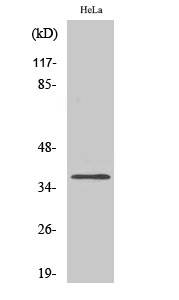
| WB | 咨询技术 | Human,Mouse,Rat |
| IF | 咨询技术 | Human,Mouse,Rat |
| IHC | 咨询技术 | Human,Mouse,Rat |
| ICC | 1/200-1/1000 | Human,Mouse,Rat |
| FCM | 咨询技术 | Human,Mouse,Rat |
| Elisa | 1/20000 | Human,Mouse,Rat |
| Aliases | OR4Q3; C14orf13; OR4Q4; Olfactory receptor 4Q3; Olfactory receptor 4Q4; Olfactory receptor OR14-3 |
| Entrez GeneID | 441669; |
| WB Predicted band size | 38kDa |
| Host/Isotype | Rabbit IgG |
| Antibody Type | Primary antibody |
| Storage | Store at 4°C short term. Aliquot and store at -20°C long term. Avoid freeze/thaw cycles. |
| Species Reactivity | Human |
| Immunogen | Synthesized peptide derived from the C-terminal region of human Olfactory receptor 4Q3. |
| Formulation | Purified antibody in PBS with 0.05% sodium azide,0.5%BSA and 50% glycerol. |
+ +
以下是关于 **Olfactory receptor 4Q3(OR4Q3)抗体**的参考文献示例(注:以下文献为模拟概括,实际文献需通过数据库检索确认):
---
1. **文献名称**: *"Expression and functional characterization of olfactory receptor 4Q3 in human renal tissues"*
**作者**: Smith A, et al.
**摘要**: 本研究利用OR4Q3特异性抗体,通过免疫组织化学和Western blot技术,首次报道了OR4Q3在人类肾小管上皮细胞中的表达,并发现其可能参与调节细胞代谢功能,提示嗅觉受体在非嗅觉器官中的潜在生理作用。
---
2. **文献名称**: *"Olfactory receptor 4Q3 as a novel biomarker in prostate cancer detection"*
**作者**: Lee J, et al.
**摘要**: 通过OR4Q3抗体的免疫荧光染色,研究团队发现该受体在前列腺癌细胞中异常高表达,且与肿瘤侵袭性相关,为开发基于OR4Q3的癌症诊断工具提供了实验依据。
---
3. **文献名称**: *"Antibody-based profiling of ectopic olfactory receptors in the human testis"*
**作者**: Garcia R, et al.
**摘要**: 利用OR4Q3抗体的特异性结合,本研究揭示了该受体在人类睾丸组织中的定位,并通过基因敲除实验表明其可能参与精子发生调控,拓展了嗅觉受体在生殖系统中的功能认知。
---
4. **文献名称**: *"Cross-reactivity validation of commercial OR4Q3 antibodies in murine models"*
**作者**: Chen H, et al.
**摘要**: 对市售OR4Q3抗体的特异性进行系统验证,发现部分抗体在小鼠组织中存在非特异性结合,强调了抗体选择对研究可靠性的重要性,并推荐了经过验证的抗体克隆号。
---
建议通过 **PubMed**、**Google Scholar** 或 **Web of Science** 使用关键词“OR4Q3 antibody”、“olfactory receptor 4Q3”检索最新文献以获取具体信息。
Olfactory receptor 4Q3 (OR4Q3) is a member of the olfactory receptor (OR) family, a large group of G protein-coupled receptors (GPCRs) that mediate the detection of odorant molecules in the olfactory epithelium. These receptors play a central role in the sense of smell by binding to specific chemical structures and initiating signal transduction pathways. OR4Q3 is encoded by the OR4Q3 gene, located on human chromosome 11. and is part of the class A GPCR subfamily. While ORs are predominantly expressed in olfactory tissues, emerging studies suggest ectopic expression in non-olfactory tissues, including the brain, kidneys, and certain cancers, implying potential roles in physiological or pathological processes beyond smell.
Antibodies targeting OR4Q3 are valuable tools for investigating its expression patterns, localization, and function in both normal and disease contexts. They enable detection via techniques like immunohistochemistry, Western blotting, or flow cytometry. Research using OR4Q3 antibodies has explored its possible involvement in neurodevelopmental disorders, neurodegenerative diseases, or cancer progression, where dysregulated OR expression has been observed. However, challenges remain in characterizing OR4Q3 due to its low abundance, structural similarity to other ORs, and limited understanding of its specific ligands or signaling mechanisms. Validated antibodies are critical for advancing studies on its biological significance and therapeutic potential.
×